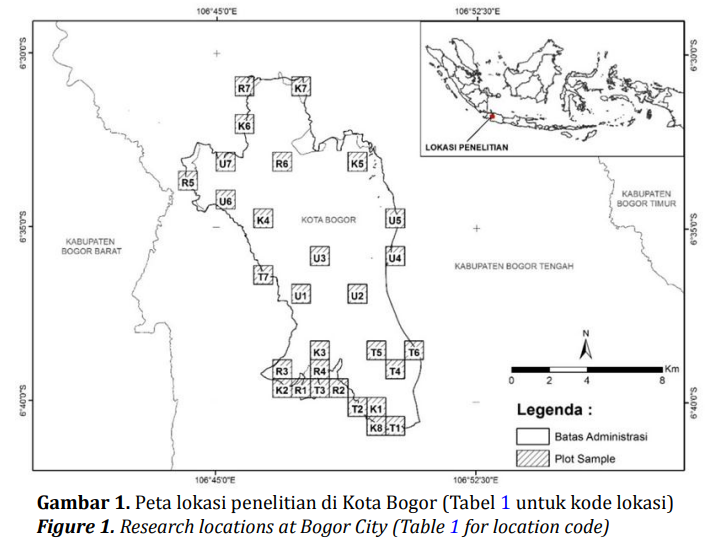Landscape Structure Affects Bird Community in Bogor, West Java

Downloads
Birds have different responses to landscape modification, depends on its adaptation to the environment. The purposes of this study were to identify bird communities in several landscape types and to analyze the landscape structures that affect bird communities. The study was conducted from April to August 2016 at 29 landscapes in the city of Bogor. The landscapes were categorized into four types based on their fragmentation stages: intact, variegated, fragmented, and relict. Birds were surveyed using point count. Bird diversity was calculated using Shanon-Wienner Index, followed by Kruskal-Wallis statistical analysis, the similarity of communities was tested using Bray-Curtis. The landscape structures were quantified using 7 variables and measured using ArcGis patch analyst. Total 8,967 individuals from 75 species and 36 families were recorded. Similarity analysis of the bird community suggested that intact landscapes were clustered separately, while other three types were clustered together. The results showed that the abundance and species richness were higher in intact landscape. Bird diversity in Bogor becomes higher when the total edge, the mean shape index, and the shannon evenness index become smaller.
Asmoro, A.W.T. (2012). Keanekaragaman jenis burung pada beberapa cluster perumahan di Sentul City, Bogor Jawa Barat (Skripsi). Bogor: Institut Pertanian Bogor.
Caula, S., Villalobos A., & Marty, P. (2014). Seasonal dynamics of bird communities in urban forests of a Mediterranean city (Montpellier, Southern France). Urban Ecosystems, 17(1), 11–26.
Clough, Y., Putra, D.D., Pitopang, R., & Tscharntke, T. (2009). Local and landscape factors determine functional bird diversity in Indonesian cacao agroforestry. Biological Conservation, 142, 1032- 1041.
Fardila, D., & Sjarmidi, A. (2012). Bird distribution along environmental gradients in North Bandung, West Java. Research Journal of Recent Sciences, 1, 23-32.
Hadinoto, Mulyadi, A., & Siregar, Y.I. (2012). Keanekaragaman jenis burung di hutan Kota Pekanbaru. Jurnal Ilmu Lingkungan, 6(1), 25-42.
Hafif, A.R. (2013). Struktur komunitas burung di Kawasan Karst Citatah, Kecamatan Cipatat, Kabupaten Bandung Barat, Jawa Barat (Skripsi). Jatinangor: Universitas Padjadjaran.
Hortal, J., Triantis, K.A., Meiri, S., Thebault, E., & Sfenthourakis, S. (2009). Island species Richness Increases with habitat diversity. The American Naturalist, 174(6), E205-E217.
Gunawan, H., Prasetyo L.B., Mardiastuti, A., & Kartono, A.P. (2009). Fragmentasi hutan alam lahan kering di Provinsi Jawa Tengah. Jurnal Penelitian Hutan dan Konservasi Alam, 7(1), 75-91.
Kurnia, I. (2012). Keanekaragaman spesies burung dan amfibi pada lanskap didominasi Manusia di wilayah Bogor (Tesis). Bogor: Institut Pertanian Bogor.
Magurran, A.E. (2004). Measuring biological diversity. USA: Blackwell Publishing Company.
Mardiastuti, A. (2015). Ekologi satwa pada lanskap yang didominasi Manusia. Bogor (ID): Fakultas Kehutanan Institut Pertanian Bogor.
Marzluff, J.M., DeLap, J.H., Oleyar, M.D., Whittaker, K.A., & Gardner, B.(2016) Breeding dispersal by birds in a dynamic urban ecosystem. PloS One, 11(12), e0167829. Doi: https://doi.org/10.1371/journal.pone. 0167829.
Mulyani, Y.A., Ulfah, M., & Sutopo. (2013). Penggunaan berbagai tipe habitat oleh burung di Kampus Institut Pertanian Bogor, Darmaga, Bogor, Jawa Barat. Media Konservasi, 18(1), 18–27.
McGarigal, K., &. B.J. Marks. (1995). FRAGSTATS. Spatial analysis program for quantifying landscape structure. USDA Forest Service General Technical Report PNW-GTR-351. Portland, OR.
Melles, S.J. (2005). Urban bird diversity as an indicator of human social diversity and economic inequality in Vancouver, British Columbia. Urban Habitats, 3(1), 25-48.
Mokotjomela, T.M., Musil, C.F., &. Esler, K.J. (2013). Potential seed dispersal distances of native and non-native fleshy fruiting shrubs in the South African Mediterranean climate region. Plant Ecology, 214, 1127-1137.
Nielsen, A.B., van den Bosch, M., Maruthaveeran, S., & van den Bosch, C.K. (2014). Species richness in urban parks and its drivers: a review of empirical evidence. Urban Ecosystems, 17(1), 305–327. Doi: https://doi. org/10.1007/s11252-013-0316-1.
Prasetyo, L.B. (2017). Pendekatan ekologi lanskap untuk konservasi biodiversitas. Bogor: Fakultas Kehutanan, Institut Pertanian Bogor.
Rahayuningsih, M. (2009). Komunitas burung di Kepulauan Karimun Jawa Tengah: Aplikasi teori biogeografi pulau (Disertasi). Bogor: Institut Pertanian Bogor.
Saefullah, A. (2015). Keanekaragaman jenis Burung pada beberapa tipe habitat di Hutan Penelitian Dramaga, Bogor, Jawa Barat (Skripsi). Bogor: Institut Pertanian Bogor.
Shih, W.,Y. (2017). Bird diversity of greenspaces in the densely developed city centre of Taipei. Urban Ecosystems, Doi: https://doi.org/10.1007/s11252-017-0720-z.
Sushinsky, J.R., Rhodes, J.R., Possingham, H.P., Gill, T.K., & Fuller, R.A. (2013). How should we grow cities to minimize their biodiversity impacts?. Global Change Biology, 19(2), 401–410. Doi: https://doi.org/10.1111/gcb.12055.
Tagliapietra D., & Sigovini, M. (2010). Biological diversity and habitat diversity: a matter of Science and perception. Terre et Environnement, 88, 147–155.
Tian, G., Qiao, Z., &. Gao, X. (2014). Rural settlement land dynamic modes and policy implications in Beijing metropolitan region, China. Habitat International, 44, 237–246.




